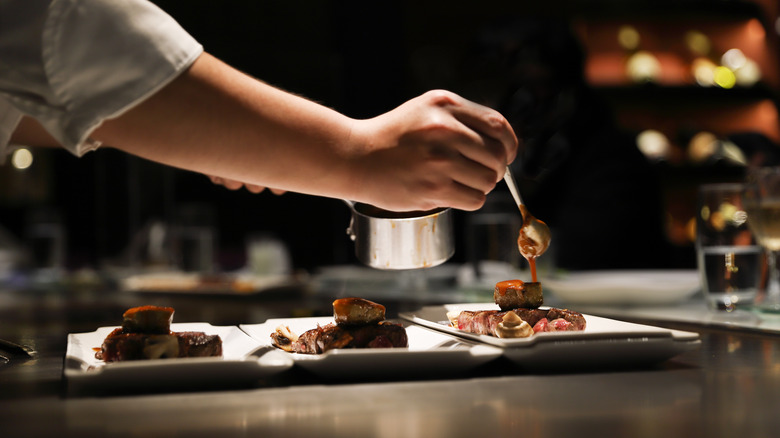Does A 5-Star Restaurant Actually Exist?
The term "five-star" has come to denote the best of the best. It's the highest rating possible on e-commerce sites like Amazon and Wayfair. It's the best review you can give a song on Apple Music. The highest military rank in many countries? That's right, five-star general. Somehow, we've all accepted five as the ideal number of stars. Well, all of us except for the restaurant industry.
The most prestigious rating system in the world of food is the Michelin Guide, a travel guide published by the French tire company of the same name. The Michelin star system asks whether or not a restaurant is worth visiting. A one-star restaurant is worth a stop if you're in the area, a three-star restaurant is worth traveling to another country for, and a five-star restaurant ... doesn't exist. The Michelin Guide only goes up to three stars.
When people talk about a star system for rating restaurants, they most likely think of the Michelin Guide. In this sense, there is no such thing as a five-star restaurant, but who says Michelin has to be the ultimate authority on food? Its guides only cover 37 countries, excluding many types of global cuisine, and in the internet era, a whole new crop of rating systems has arisen with a much broader scope (and a few extra stars to boot).
Where does the five-star rating system come from?
Star ratings originated outside the restaurant industry. They were first used for hotels and tourist sites during the Golden Age of Travel in the early 1800s when steam-powered trains and ocean liners made mass travel for leisure purposes feasible for the first time. English travel writer Mariana Starke kicked off the concept in her 1820 book "Travels on the Continent," wherein she ranked notable works of art not with stars but with exclamation points. The first use of a star system is credited to Germany's Karl Baedeker, who started publishing travel guides in 1827. He didn't use five stars, though. Instead, he gave exceptional hotels a single star to separate them from the pack. Top tourism sites got two stars, but that was all.
The concept of a five-star system was popularized in the mid-20th century by the Mobil Gas Corporation. In 1958, it published the first Mobil Travel Guide, listing the best hotels, spas, and places to eat around the U.S. As with the Michelin Guide before it, this was initially done to encourage people to drive more and thus use more gas and tires. Unlike Michelin, however, Mobil elected to use a five-star rating system. This soon became the standard for rating hotels, and modern travel sites like TripAdvisor have continued that trend. However, the restaurant industry has also gotten on board now.
Yes, there are five-star restaurant rating systems
The Michelin Guide may be the most famous restaurant rating system, but it is far from the only one. The Mobil Travel Guide was rebranded in 2009 as the Forbes Travel Guide and continues using the five-star system. Its pentagonal five-star logo can be seen at hotels and restaurants worldwide. The American Automobile Association (AAA) guide follows a similar scale for rating restaurants and hotels, except it uses five diamonds rather than five stars.
The rise of the internet means that we are no longer dependent on professional guides for restaurant ratings. Yelp and Google Reviews have allowed everyday diners to voice their opinions to a broad audience. These sites use five-star systems, as do most customer review services like Amazon and UberEats. We've gotten used to thinking of the consumer experience from a one-to-five-star perspective, so much so that "five-star" essentially refers to anything we'd consider exemplary, even if it hasn't received an "official" five-star rating.
Then you have restaurant review systems that don't use stars at all. The Zagat rating system was quite prestigious in the American restaurant scene from the 1980s to the 2000s before the company was sold. It grades restaurants on a scale of up to 30 points. Even Michelin doesn't exclusively stick to its three-star scale. It also awards the Bib Gourmand for dining on a budget and the Michelin Green Star, a single star used to grade eco-friendly eateries.


